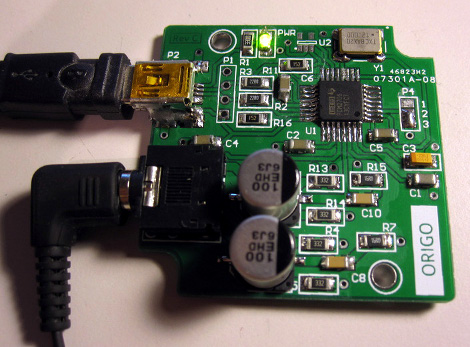
[Entropia] decided to try his hand at rolling is own sound card. He picked out a DAC chip, started his prototyping by studying the reference design from the datasheet, then went through several iterations to arrive at this working model.
He chose to base the board around the PCM2706. It’s a digital to analog converter that has built-in USB support; perfect for his needs. It’s got a headphone amplifier, but is also capable of putting out S/PDIF signals for a digital amplifier to pick up and use. Not bad for a part that can be had for right around eight bucks.
The first PCB he designed had a few electrical and footprint errors. But he was able to get it to run by adding some point-to-point jumpers, and bending the legs of his capacitors to fit the board area. With those issued accounted for he ordered a second batch of boards. These went together nicely, but the headphone output was incredibly loud. Turns out the filtering circuit had the wrong resistor and capacitor values. Changing them around, and swapping the audio output so that the correct channels were patched to the audio jack brings it to the first release version seen above.















This guy is making a “pro” quality usb dac and headphone amplifier (as separate components designed to work together if desired). Seems like an interesting blog – lots of technical data and discussion.
Great Project with Excellent Documentation!
Made a PCM 2702 board about 5 years ago. Worked intermittently until i realized the missing 1Mohm resistor across the crystal. After that, all perfect. I use it every time i test an amplifier or something like that so i don’t harm the one on the laptop. Never broke it, though.
My first mistake too, build many many of these PCM2900. Realy nice chip!
Are those electrolytics in the analog audio signal path?
They are, the board is powered from single 5V supply so DC decoupling is necessary.
Yup and all consumer grade audio junk uses electrolytes in the audio path.
I have never seen a decent soundcard that used polypropylene or other correct components for audio path
If this guy went to all the trouble to make his own DAC, this would have been the opportunity to improve on commercial designs, no?
Definitely needs to check out NWAVGuy.
Did anybody actually read the article? He specifically notes that he is going to replace them with higher quality caps typically used for this purpose in audio.
Hmm, I’ve been looking to design a really cheap 16/32 bit (no audio processing) multiple channel usb dac. I’ve been looking at c-media chips.. but they seem to be hard to get anybody know of a good 5+ channel alternative?
Coincidentally, I am debugging my own PCM2707 design at the moment.
It is still at the “alpha” stage – still failing to work.
I’m glad to see that someone has had success with this chip family, though!
Actually, i was going to post a “no arduino involved?”, but something like this should be possible usig the atmega8u…
New quest added to my list…
Can this handle the wave standard of 1,411kb’s per second?
I’d love to do something similar, so does the DAC chip do all the work? As in gets it’s self enumerated as a sound card?
Hi guys, thanks for the comments!
tony/fartface: Yes, at the moment there are electrolytics. The Nichicon tantalums are on their way from Digi-Key as we speak, I hope that will enhance the way it sounds. I’m all ears if you can provide good tips to improve the sound!
Alex Rossie: Yes, PCM2706 does everything. You only need passive components and it will do all the rest.
I’ve never heard of using tantalums in the signal path. I’d avoid using any polarized components in the signal path. Instead maybe have this drive a headphone amp that doesn’t have a single supply. Avoid the capacitor issue altogether. A -5V switching regulator wouldn’t be too hard to implement on the board. http://cds.linear.com/docs/Datasheet/1614fs.pdf
Something like that so that you can make split rails. I’m not sure how much current your headphones need(are the 4 ohm vs 16 vs 200). I don’t think this would be suitable for lower impedances. Anywho just a thought.
Those issues with the headphone output nicely shows what many manufacturers go through too I bet.